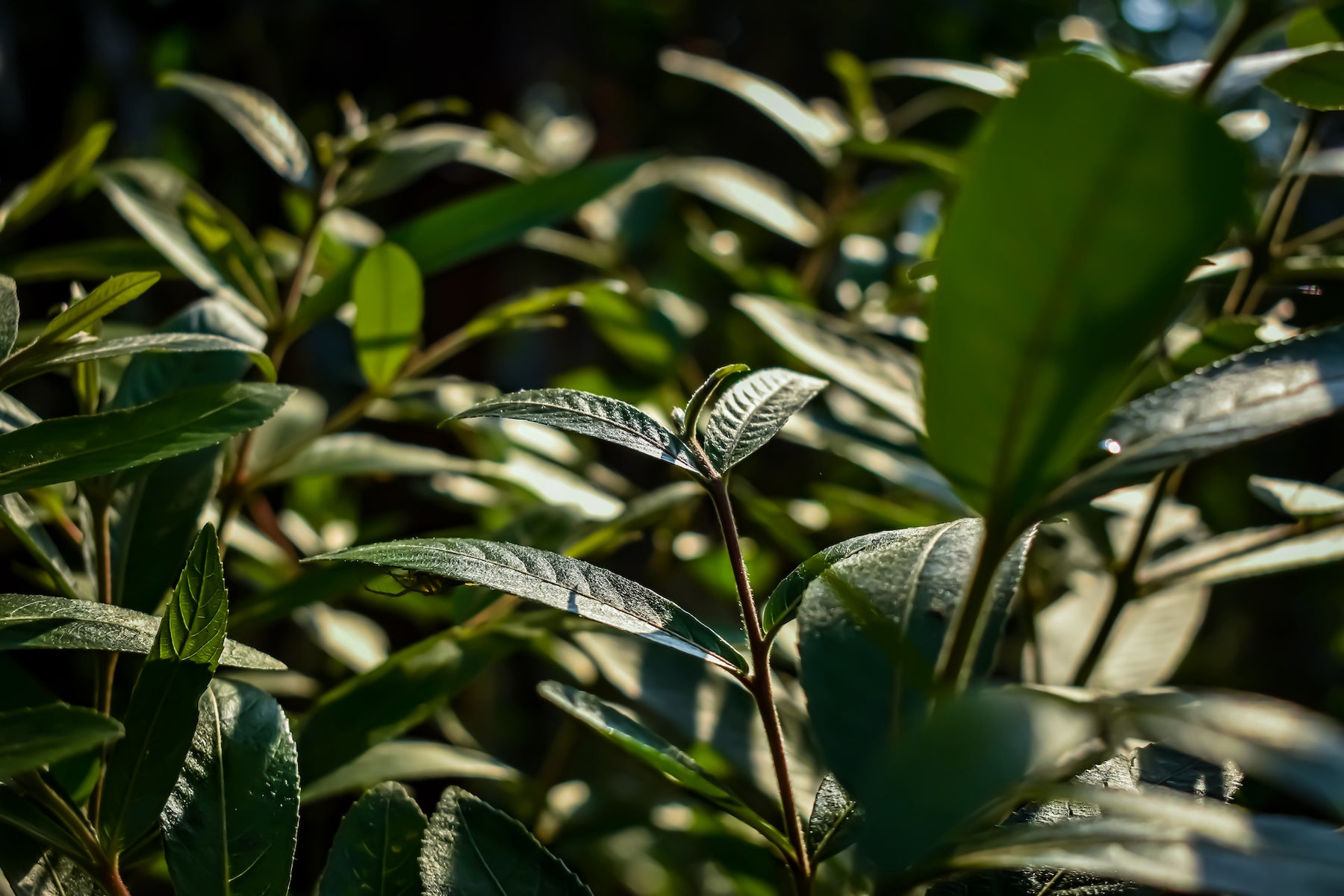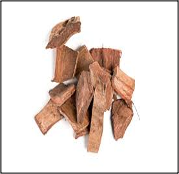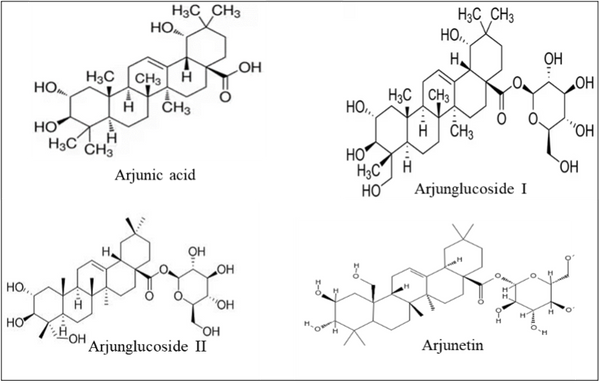
Terminalia arjuna
Terminalia arjuna is an ayurvedic plant with significant therapeutic value. It is commonly known as Arjuna, Indradru, Partha and Veeravriksha, and is indigenous to the Indian subcontinent.
We at Herbal Apothecary are proud to supply T. arjuna tincture and bark in cut, powdered and capsule form to our customers. We also produce an Arjuna Tincture.
Biological Source
Terminalia arjuna belongs to the Combretaceae family, comprising of nearly 200 species (Journal of Traditional and Complementary Medicine 7 (2017) 65-78) spread around the world, many of which are used in diverse traditional medicines for various purposes.
Background and Historical uses of Terminalia arjuna
The thick, white to pinkish grey bark of T. arjuna has been used in India’s native Ayurvedic medicine for three centuries, primarily as a cardiac tonic. Chakradatta, the great ancient physician, recommended it to be given as a decoction of bark with milk or as a ghrita (a preparation with ghee or butter) (J Tradit Complement Med. 2014 Oct-Dec; 4(4): 224–231). Fresh leaf juice is used for the treatment of earache and bark powder for treating heart ailments by Malabar tribe, Kerala (Tradit Knowledge. 2007; 6:481–5). Tribals living in Sundargarh District, Orissa use dried bark powder along with rice washed water to treat blood in urine, and tribes living in Malkangiri district chew the fresh bark and swallow the juice as an antacid (India. Ethnobot Leafl. 2007; 11:148–63).

Fig 1: T.arjuna bark cut

Fig 2: T.arjuna bark
Macroscopical Details
The arjuna tree is about 60-80 ft in height, and is seen along rivers, streams, and dry water bodies. The outer surface of the bark is smooth, while the inner surface has longitudinal striation and is pinkish in colour. The bark flakes off itself in the months of April–May (Egypt J Forensic Sci 2013; 3:15‑9). An internal view of the bark reveals that it is soft and reddish in colour. Leaves of T. arjuna are simple, often crenulations, borne subopposite, shortly acute or obtuse at the apex, coriaceous and oblong or elliptic. Their upper face is pale or dark green and the lower face is pale brown. The tree bears white sessile bisexual flowers in short auxiliary spikes or in a terminal panicle arrangement. Fruits of T. arjuna are drupe, ovoid, fibrous-woody and smooth-skinned with five hard wings or angles which are oblique and curved upwards. Flowers are white in colour and bisexual, arranged in spikes with linear bracteoles.
Phytochemical Details
Terminalia arjuna embraces many phytochemicals in root bark, stem bark, leaves, fruits, and seeds. T. arjuna is considered to be a crucial constituent from a medicinal point of view due to the presence of flavonoids, tannins, glycosides, polyphenols, saponins, triterpenoids, sterols, and minerals such as zinc, calcium, magnesium, copper, amino acids (Journal of Pharmacognosy and Phytochemistry, 4(3):186-193). Stem bark of T. arjuna has been reported to have the presence of arjunic acid, arjunetin and arjungenin and the presence of two more glucosides namely arjunglucoside I and II has been recently reported. T. arjuna bark is known to contain a very high level of flavonoids in comparison to other commonly used plants in Ayurveda. Types of flavonoids found in the bark of the plant are arjunone, luteolin, quercetin, flavones, gallic acid, ethyl gallate, baicalein, proanthocyanidins, catechin, gallocatechin, pelargonidin and kaempferol (Journal of Traditional and Complementary Medicine 4 (2014) 224‑231). Stem bark of T. arjuna has also been reported to contain glycosides such as arjunaphthanoloside and terminoside A. The following diagrams show the structure of glycosides present in T. arjuna bark.

Fig 3: Glycosides present in T. arjuna bark.
Around fifteen types of tannins and their related compounds were isolated from the bark of T. arjuna. Hydrolyzable tannins astragalin, casuariin, casuarinin, punicalagin, pyrocatechols, punicallin, terchebulin and terflavin C were isolated from the bark of T. arjuna. The bark of T. arjuna contains substantial amount of various minerals and trace elements such as magnesium (4000 mg/g), calcium (3133 mg/g), zinc (119 mg/g) and copper (19 mg/g).47 It contains some amino acids such as tryptophan, tyrosine, histidine, and cysteine (Journal of Traditional and Complementary Medicine 7 (2017) 65-78).
Medicinal Uses
The different parts of the plant, such as the fruit, bark, leaf, seed, and root are found to hold diverse medicinal properties. Among these, bark has been found to have a rich medicinal value. T. arjuna is one of the most used plants in the Siddha, Ayurveda, and Unani systems of treatment (Pharmaceuticals 2023, 16(1), 126).
Cardioprotective
Terminalia arjuna, is popularly known as the 'tonic of the heart' plant due to its high utility in treating the heart since ancient times. Various scientific studies have reported on the use of T. arjuna bark for treating the heart. Triterpenoids are essentially responsible for the cardiovascular properties of the bark (Annals of Phytomedicine 10(1): 62-73, 2021). With reference to available data, T. arjuna is widely used for the treatment of cardiovascular diseases, including heart diseases and related chest pain, high blood pressure and high cholesterol. Vascular complications are a leading cause of mortality and morbidity in diabetic patients. The therapeutic potential of T. arjuna bark extract was examined and shown to improve myocardial function in diabetic models, by improving the function of endogenous antioxidant enzymes which are ultimately responsible for reducing stress. (J Cardiovasc Pharmacol Ther. 2013 Sep;18(5):481-9).
Antibacterial Activity
Extracts of T.arjuna bark have been reported to be antimicrobial against multidrug resistant Salmonella typhi, Pseudomonas aeruginosa and Staphylococcus aureus along with moderate antifungal effect against Microsporum canis (Phytother. Res., 18:670-673.2004). The arjuna leaves and bark extract has been found to be effective in retarding the growth of organisms causing ear infections and thus is used to formulate herbal ear drops. These herbal ear drops have been found to be more efficient when compared to the standard ear drops (Brazilian Journal of Otorhinolaryngology, 78:68-74.2012). T. arjuna extracts have also been found to be medicinal in nature by inhibiting respiratory pathogens that cause infections in the lower and upper respiratory tract region (International Journal of Current Research, 6:8003-8005. 2014).
Hepatoprotective
T. arjuna has been shown to have an excellent hepato guarding effect. There was a reduction in various enzymes like serum alkaline phosphatase, serum glutamic pyruvic transaminase, serum glutamic oxaloacetic transaminase and serum bilirubin, which were found to be at the same levels, when treated with a standard hepatoprotective (International Journal of Pharmaceutical Archive, 2(10):1-7 2013). Arjunolic acid has been studied for its hepatoprotective potential against arsenic induced hepatotoxicity. Results suggest that arjunolic acid possesses the ability to attenuate arsenic-induced oxidative stress in murine liver probably via its antioxidant activity (Clin Pharmacol Toxicol. 2007 Nov;101(5):333-8). Aqueous extract of arjuna bark has been reported to be effective in treating alcohol induced nephrotoxicity, by mitigating the levels of lipid peroxides and restoration of enzymatic along with nonenzymatic antioxidants in liver. (International Journal of Phytomedicine, 7:142-153, 2015.) Furthermore, arjuna extract has a protracted beneficial effect in curing non-alcoholic fatty acid liver disease by reducing the lipid levels in palmitate oleate incubated HePG2 cell and by minimizing the activity of lactate dehydrogenase (LDH), alanine aminotransferase (ALT), aspartate transaminase (AST) and gamma glutaryl transferase (GGT) (Biomed Pharmacotherapy, 107:979-988).
Wound-healing Potential
T. arjuna bark powder has been reported to treat chronic wounds along with coconut oil (Journal of Ayurvedic and Herbal Medicine, 2:102-103,2016). Reports suggested that the presence of superior tannin content makes this bark beneficial against dermal wounds.
Anti-inflammatory and Analgesic Potential
The stem bark of T.arjuna exhibited anti-inflammatory and analgesic activities. The mechanisms of anti-inflammatory activity may be related to the antiphlogistic action of the tannins. Flavonoids and other phenolics compounds of plant origin have been reported as antioxidants and as scavengers of free radicals. Antioxidants can also exert anti-inflammatory effects (Bioinformation 19(2): 184-189 2023).
Gastroprotective
Various studies have reported that arjuna has great potential to curb the damage caused to gastric mucosa by different agents. Reports by scientists confirmed the antiulcer effects of extract of T. arjuna against Helicobacter pylori lipopolysaccharide mediated gastric damage. This extract was also found to enhance the adherent mucus in the gastric walls along with the protein bound carbohydrate molecules of gastric juices in diclofenac treated rats models (Journal of Pharmacy and Pharmacology, 60:505-514.2007).
Further Health Benefits of T. arjuna
T.arjuna has been known in ayurveda as one of the most influential and effective herbs for health benefits since ancient times.
Apart from the aforementioned potential, Arjuna has also proved its potential as antimicrobial, antioxidant (J Tradit Complement Med. 2017 Apr 23;8(1):100-106), antitumoral (World J Gastroenterol. 2006 Feb 21;12(7):1018-240), anti-HIV (Pharmacogn Rev. 2016 Jul-Dec;10(20):73-83).
Studies on the Incorporation of T. arjuna in Food Products
Arjuna Ghee
Arjuna ghee has been established as extending valuable health effects against cardiovascular disease. The ghee has demonstrated more stability to oxidative deterioration as compared to traditional ghee owing to the rich phenolic bioactive compounds present in T. arjuna plants. Consumer acceptability of this product based on sensory evaluation has been shown to be very good (J. Asian Nat. Prod. Res., 3(3):207-212).
Herbal Multigrain Biscuits
The use of T.arjuna at 2, 4 and 6% was assessed for the development of herbal multigrain biscuits as a cardiotonic. The results revealed that 2% T. arjuna containing biscuits had lesser ash content, lower spread ratio, nominal diameter, less moisture, and more thickness in comparison to control biscuits. Incorporation of T. arjuna at 2% did not affect the overall acceptability of the biscuits and possesses potential to enhance the nutritional status for people with cardiac diseases, without decreasing the sensory acceptability of the composite biscuits (Int. J. Fauna Biol. Stud., 5:228-232).
Arjuna churna
Churna is a mixture of powdered herbs and minerals which are used in Ayurvedic medicine. Arjuna churna is sold under different names by differing brands. This churna is used most popularly to prevent heart ailments (J Tradit Complement Med. 2014 Oct;4(4):224-31).
Written By
Dr. Bhagyashree Kamble
Propolis Research Associate
University of Bradford UK
Nature’s laboratory, Whitby UK
